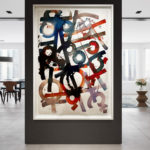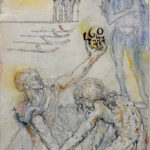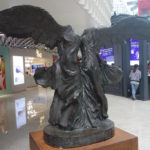
In 2002, upon the unveiling of his September 11th-related sculpture Tumbling Woman, American sculptor and painter Eric Fischl weathered a veritable whirlwind of negative criticism and outright vitriol. Students, scholars and the general public lambasted the grotesque bronze as being in extraordinarily poor taste. The sculpture, depicts one of the estimated 200 victims who leaped to their deaths in the final split second before their body landed on the ground. It’s vicious realism, and frank portrayal of the days events horrified viewers in Rockefeller Center, many of whom witnessed the events occur, and knew the individuals involved.
The sculpture, when taken solely upon aesthetics, is a valid and noteworthy work, in the recumbent sculptural tradition of French Master Auguste Rodin’s “Martyr”and Aristide Maillol’s “The River”. The coarse texture evokes Rodin’s bronzes cast from the famous Alexis Rudier foundry; which were more landscape-like and provided viewers with the sense of motion, undulating waves… or in this case, flight.
A plaque near the sculpture read Fischl’s words: “We watched, disbelieving and helpless, on that savage day. People we love began falling, helpless and in disbelief.”

One wonders if the context and timing were the most limiting factors in the public’s overwhelming and swift reaction to this sculpture. Understandably, many will not search for the deeper meanings in Art and most will jump to the most convenient and obvious conclusions about its author. The general public simply had not had the time to digest and reflect upon the events of that day, or to lay to rest the savage reality of an event which altered lives world-wide. Television programs recycled images of the planes plunging into the towers so often that we became numb. We imagined…. questioned…. dreamt.
Sculpture has been a method of remembering for centuries. Not simply monuments whose heroic subjects can be portrayed in a prideful or positive light but often sculptures which require us to get our hands dirty mentally. We build permanent monuments for fallen soldiers, firefighters, police officers, victims of massacres and innocents that we choose not to forget quite so easily. We erect pillars to signify victory, defeat or the location of something significant. We place sculptures on mausoleums to honor family and friends. We use sculpture in an attempt to have a permanent physical reminder of our emotions, both positively and negatively. Where many monuments in the past many have made us feel good, we have entered an age where we require our monuments to be a bit disquieting, humbling and sometimes somber remembrances. Whether the public has demanded this, or whether artists have dictated it, remains open to debate.

What is certain is that artists often depict negative or pessimistic views in order to assimilate the zeitgeist metaphorically. Artists and writers during the 18th and 19th centuries conjured images of tempestuous locales that assisted the public in processing the events, politics and angst of contemporary society. The general trepidation at the dehumanization which many felt would be firmly implanted in the new century caused society to look towards the arts for solace in Utopian lands where native girls danced, the sun shone brightly and alcohol flowed copiously. Auguste Rodin cynically approached the prevailing winds and with morose, sullen and vacant characters. He used the public’s angst to shock Salon viewers with images they were unaccustomed to and uncomfortable with. He depicted nude bodies erotically twisting in the Hell wrought by Dante and Milton, the wicked gardens of Baudelaire; the locales frequented by Bosch, Carpeaux and Doré. Ironically, we enter a similar ideological crossroads as we forge the roots of our new Millennia.
“The ugly in art is that which is false; that which is artificial; that which seeks to be pretty or beautiful, instead of being expressive…”- Rodin, as quoted by Gsell
It is perhaps ironic that on September 11, 2001, portions of the largest American collection of Rodin sculpture were held within the offices of Cantor Fitzgerald, housed on the 105th Floor of the North Tower of The World Trade Center.
***********
Kenneth Treister’s “Holocaust Memorial” in Miami Beach, Florida is a monument which encompasses viewers in a labyrinthine maze which closes in on the viewer bit by bit, stone by stone. This makes the revealing of the enormous hand pleadingly thrust toward the sky all the more jarring. The hand pleads for breath. Menacing numbers adorn the forearm as bodies (souls) writhe in a viscous, pullulating mass of primordial muck. Mothers clutch dying babies as their husbands attempt to embrace them one last time. Lifeless, eyeless and emaciated corpses pile one on top of another in an effort to find air.
It is painful to look at. It is painful to walk down the stone hallway to the courtyard it is housed within. An architect by trade, Treister’s hallway narrows into a veritable gas chamber, while the names of the camps adorn the headstones. Auschwitz, Bergen Belsen, Dachau. Sobibor. Buchenwald. The endless litany of names of the dead extends in an arc around in a tombstone of black marble.
The pain is made all the more tangible for those individuals who survived. Smelled the death. Felt the cold. But it also gives the contemporary viewer the sense of impending doom, despite our safety and distance from the events themselves.

One reminisces of Constantin Brancusi’s (1876-1957) Le Supplice I, from 1906, which depicts a twisted child wincing in pain, or Medardo Rosso’s (1858-1928) tormented busts of melting flesh on sick and dying children.
This is what a monument does, and is meant to do… Make you remember. And for those who do not remember… it allows us not to forget.
However, would this work be accepted if it was designed and built within months following the liberation of these camps? Possibly not.

The trauma has been digested and processed. Remembered vividly, but muted in a way that allows monuments such as this to offer some measure of healing. Treister’s statement, much like Fischl’s, serves as mute testimony to enrage a people into insuring that events such as this do not take place again.
“In all works … dense, anxious in researches,
burning, we should not forget, with the long hand-to-hand of the artist with his art,
the human body, face, arms, hands,
the all body plays the drama.”
-Antoine Bourdelle
What did we do on Sept 12? We picked ourselves up. Dusted ourselves off. And DECIDED we could not afford to forget. We placed American flags on our cars, and in our yards. The sunlight has faded their color and the wind tattered their edges, but they stood sentry for us as faceless reminders. They provided us assurances that, despite the Pandora’s box of pain which remains gaping in our national landscape… we will, for better or worse… Remember.






